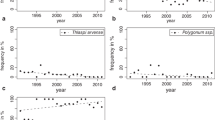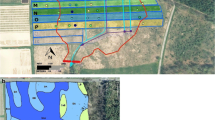Abstract
Field experiments were conducted on a tropical Inceptisol at Apia, Western Samoa to evaluate the effects of alley cropping on soil characteristics, weed populations, and taro yield. Taro yields were compared from Calliandra calothyrsus and Gliricidia sipium alleys, spaced at 4 m, 5 m, and 6 m, and a no tree control. Measurements were made for soil moisture and temperature, weed growth, hedge biomass production, and taro growth and yield. Data was analyzed over 4 consecutive years from 1988 to 1991.
Hedge biomass yields ranged from 5.1 to 16.1 t/ha/yr dry weight over the 4 years of the trial, with Calliandra and Gliricidia performing equally well. Biomass yields decreased by about 2 mt/ha with increasing alley width from 4 to 6 m alleys. Weed populations were significantly lower in the 4 m alleys compared to the 5 m, 6 m, and control plots. The 6 m alleys supported the significantly highest weed populations. Soil from alley plots held significantly more water in the 0.3 to 1 bar range than soils from the controls. Four years of mulch application measurably improved soil water holding capacity and bulk density. However, no improvement was seen in nitrogen, phosphorus, potassium, calcium, magnesium and organic carbon content in the alley plots compared to the controls. There was no positive yield effect of alley cropping on taro yield. Yields in the 5 m and 6 m alleys were not significantly different from the control, while the 4 m alleys produce significantly lower yields than the control. Thus, alley cropping did not prove a viable alternative to traditional shifting cultivation after 4 years of continuous cropping, in this trial.
Similar content being viewed by others
References
de la Pena RS (1991) Taro Culture. Univ of Hawaii Manoa Publication, Honolulu HI, 32 pp
Jama B, Getahum A, and Ngugi DM (1991) Shading effects of alley cropped Leucaena leucocephala on weed biomass and maize yield at Mtwapa, Coast Province, Kenya. Agroforestry Systems 13: 1–11.
Kang BT, AC van der Kruijs, and Couper DC (1989) Alley cropping for food crop production in the humid and subhumid tropics. In: Alley Farming in the Humid and Subhumid Tropics, pp 16–26, proceedings of an international workshop held at Ibadan, Higeria, 10–14 March 1986
Kidd TJ and Taogaga T (1984) Survival and herbage yield of six nitrogen-fixing trees intercropped with taro in Western Samoa. Nitrogen Fixing Tree Research Reports 2: 22–23
Lal R (1989) Potential of agroforestry as a sustainable alternative to shifting cultivation: concluding remarks. Agroforestry Systems 8: 239–242
Mannan MA and Rashid MM (1983) Effect of spacing and mulching on the yield and profitability of Panchamukhi Kachu (Colocasia esculenta). Bangladesh Journal of Agricultural Research 8(2): 12–14.
Morrison RJ, Prasad RA, and Asghar M (1986) Taxonomy of Some Western Samoa Benchmark Soils. IRETA, Apia, Western Samoa, 65 pp
Nelson DW and Sommers LE (1980) Total nitrogen analysis of soil and plant tissues. J Assoc Food Anal Chem 63(4): 770–778
Nile EH (1988) Notes on forest research and reforestation in Western Samoa 1987–1988. Department of Agric. Forests and Fisheries, Apia. Western Samoa, 110 pp
Pardales JR (1986) Effect of mulch application and planting depth on growth, development and productivity of upland taro. Annals Tropical Research 7: 27–38
Rogers S (1992) The potential for alley cropping as a sustainable land-use system in the volcanic islands of the South Pacific. South Pacific Journal of Agriculture (In press)
Rosecrance RC, Brewbaker JL, Fownes JH (1992) Alley cropping of maize with nine leguminous trees. Agroforestry Systems 17: 159–168
Sauerborn S and Koch W (1986) Weeds in taro (Colocasia esculenta (L.) Schott) in Western Samoa: their importance and germination biology. CTA technical memoir no. 3, Wageningen, The Netherlands, 14 pp
Ssekebembe CK (1985) Perspectives on hedgerow intercropping. Agroforestry Systems 3: 339–356
Tropsoils/NCSU (1987) Technical Report for 1986/87. North Carolina State University. Raleigh, NC, 168 pp
USDA (1954) Diagnosis and improvement of saline and alkali soils. In: Richards LA, ed, Agriculture Handbook No. 60, United States Department of Agriculture, Washington DC, 168 pp
Vergara NT (1987a) Agroforestry: a sustainable land use for fragile ecosystems in the humid tropics. In: Gholz HL, ed, Agroforestry: Realities, Possibilities and Potentials, pp 7–19. Martinus Nijhoff with ICRAF
Vergara NT (1987b) Abroforestry in the South Pacific: its potential uses in development of island ecosystems. Proceedings of the Technical Meeting on Agroforestry in Tropical Islands, 23–27 February, 1987, IRETA, University of South Pacific, Western Samoa, pp 13–18
Weeraratna S (1990) Sustainable production in tradition agriculture. IRETA's S Pac Agric News (8)7: 6–7
Weeraratna S and Asghar M (1992) Effects of grass and dadap mulches on some soil (an Inceptisol) properties and yield of taro (Colocasia esculenta (L.) Schott) in Western Samoa. Tropical Agriculture 69(1): 83–87
Wills D (1989) Alley cropping. IRETA's S Pac Ag News (7)8:9
Wilson JE, Opio F, and Cable WJ (1984) Review of literature on taro production and marketing in Western Samoa. Alafua Agric Bull 9(1): 72–86
Wright ACS (1963) Soils and land use of Western Samoa. New Zealand Dept. of Scientific and Industrial Research Soils Bureau-Bulletin 22, 191 pp
Author information
Authors and Affiliations
Rights and permissions
About this article
Cite this article
Rosecrance, R.C., Rogers, S. & Tofinga, M. Effects of alley cropped Calliandra calothyrsus and Cliricidia sipium hedges on weed growth, soil properties, and taro yields in Western Samoa. Agroforest Syst 19, 57–66 (1992). https://doi.org/10.1007/BF00130094
Issue Date:
DOI: https://doi.org/10.1007/BF00130094




